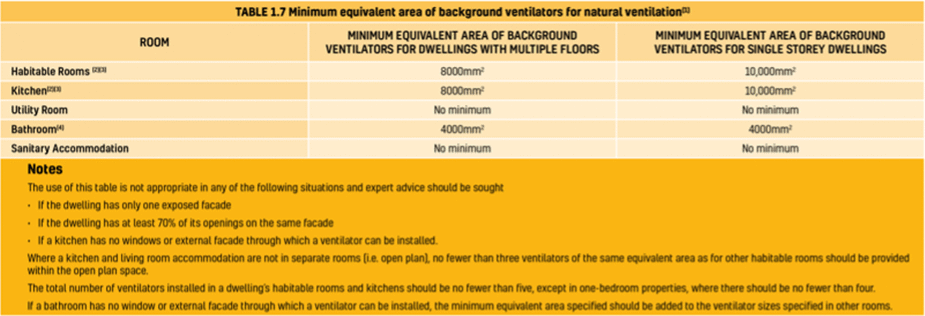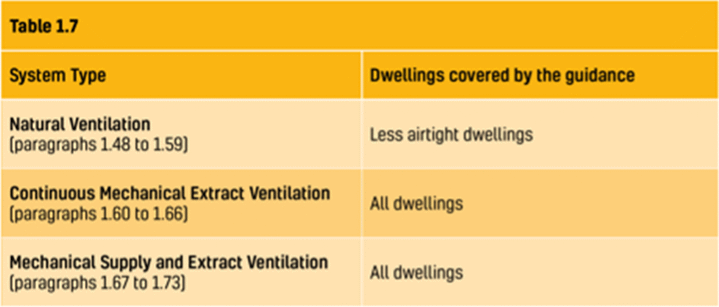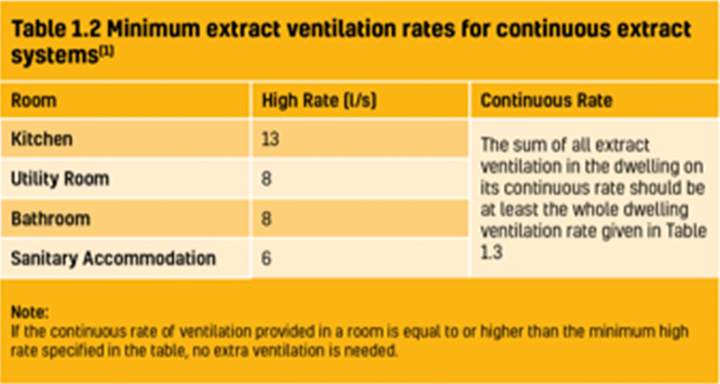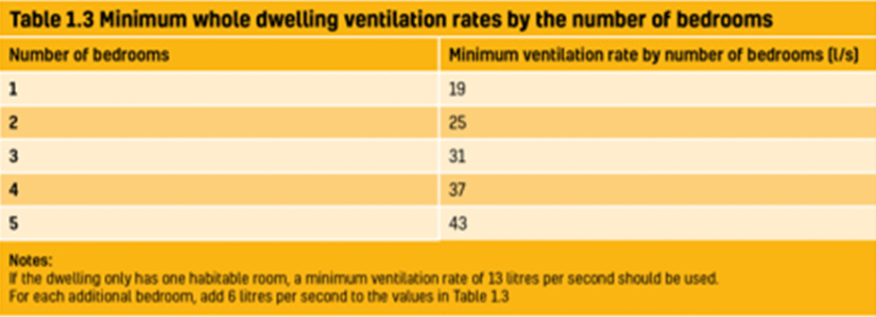Here, we have outlined the updates to ADF: Volume 1 Dwellings for England and Wales
Approved Document F: Ventilation, Volume 1: Dwellings provides guidance on meeting building regulations that specifically apply to ventilation. ADF states that:
“There shall be adequate ventilation provided for people in the building”.
It is also important to ensure adequate ventilation to protect the structure of the building.
From June 2022 for England, Approved Document F: Ventilation will be published in two volumes:
- Volume 1: Dwellings
- Volume 2: Buildings Other Than Dwellings
In Wales, as of October 2022, Volume 1 for dwellings was released. Consultations relating to the production of Volume 2: Buildings Other Than Dwellings are currently in progress into 2023.
When building a new property it is important to comply with requirements in building regulations for installation, inspection, testing, commissioning and provision of information when installing fixed ventilations systems in your new and existing property. Approved Documents provide guidance on how to meet these building regulations.
For an existing dwelling, any building work (adding a room, replacing parts of a ventilation system) should meet the relevant standards of ADF. Where any energy efficiency standards are to be carried out in a dwelling, PAS 2035 is considered an adequate means of demonstrating compliance for meeting the F1 requirement for existing dwellings: There shall be adequate means of ventilation provided for people in the building.
When inserting a new internal wall care should be taken not to make any other matters, such as ventilation, worse. If a new room is being created as a result of the addition of an internal wall then care should also be taken to ensure that the existing room is ventilated adequately. The general rules for ventilating a room are:
Ventilation Strategies
Natural Ventilation with background ventilation and intermittent extract fans.
This ventilation option was previously referred to as Intermittent extract fans and background ventilation, and involves an intermittent extract fan which is often used only when required during cooking and bathing. These are individual and found in wet rooms.
Given their intermittent nature, background ventilation such as trickle vents which can be incorporated into the head of the window framework, or by some other means are required. The requirements for natural ventilation with background ventilation and intermittent extract fans are seen below in Tables 1.1 and 1.7, and vary depending on the room being served.
Purge
This is achieved by opening the window. A system for purge should be provided for each habitable room and should be capable of achieving 4 ACH directly to outside.
If a wet room (kitchen/utility/bathroom/WC/ensuite) has no external walls and an intermittent extract fan is being used, the fan should extract at 4ACH (Air Changes per Hour) to provide purge ventilation. (In order to demonstrate compliance with Part O of the building regulations it is likely that a higher purge rate than 4ACH may be required).
The tables can be found in the following link: Approved Document F: Volume 1 applies to dwellings. Table 1.1 Page 8 of the document (16/62 in terms of general pages). Table 1.7 Page 15 of the document (23/62 generally).

Both of these forms of ventilation are normally required, however alternative approaches to ventilation may also be acceptable, subject to agreement with the building control body.
Due to the increasing complexity of the Regulations, ventilation strategies and system design must be considered at the earliest stages of building design.
Any new kitchen, bathroom (or shower room), utility room or toilet should be provided with a means of extract ventilation to reduce condensation and remove smells.
As an alternative for sanitary accommodation, the purge ventilation guidance may be used - Table 1.1 Note 3 of Approved Document F Any extract ventilation system you install should meet the requirements specified in ‘Approved Document F - Ventilation’.
In England and Wales, requirements for ventilation are contained in Approved Document F and can be downloaded from www.planningportal.gov.uk. The Building Regulations Approved Document F: Volume 1 dwellings considers ventilation through a combination of infiltration and purpose-provided ventilation. Regulations are constantly being reviewed, with the aim to improve building standards, so it is worth checking the Planning Portal website for any updates to Building Regulations.
Infiltration
An uncontrollable air exchange between the inside and outside of a building.
Purpose-Provided Ventilation
A controllable air exchange between the inside and outside of a building.
Approved Document F: Volume 1 Dwellings looks at different strategies for ventilation. The performance rates for each of the ventilation approaches set out in Approved Document F are the minimum requirements needed to ensure that adequate air quality is provided for people indoors. The occupant's health could be at risk if these ventilation rates are compromised.
The following systems are outlined which satisfy the performance standard. From June 2022 the former numbering of Systems 1-4 will cease
Natural Ventilation – Background ventilation and intermittent extract fans
Background ventilation is a whole house ventilation system that allows the introduction of fresh outside air into a habitable room without opening a window. The purpose: To remove stale indoor air and replace it with fresh outside air.
A common approach to meeting the Building Regulations Approved Document F is intermittent extract fans with background vents (i.e. trickle vents in the windows). Extractor fans are located in the bathroom, ensuite, kitchen and utility room. They must comply with providing the following ventilation airflow rates for intermittent extract minimum rates.

In addition, background ventilators (trickle ventilators) must comply with the total ventilator area (mm²) as shown in table 1.1 above.
From June 2022 natural ventilation is only recommended for use in less airtight dwellings with a design air permeability of greater than 5m3/(h.m2)@50Pa

Intermittent extractor fans can be operated with a number of different control functions: fan operates in conjunction with a light switch, remote switch, pull cord, humidistat, PIR (presence detector) or timer. Intermittent fans are not the most energy efficient way due to the heat loss incurred.
In addition, if they are not switched on, the property is not being adequately ventilated. The fans must be regularly maintained in order to work effectively and minimise sound levels.
Continuous Mechanical Extract Ventilation
Continuous mechanical extract ventilation (MEV)can be either a whole house centralised MEV system, or localised decentralised MEV fan.
The centralised continuous MEV system is typically located in a loft space or hallway cupboard. Multiple ducts run from the unit to the kitchen, bathroom, ensuites and other wet rooms of a property to simultaneously draw moisture laden air from these wet rooms to control humidity levels.
Decentralised continuous MEV (dMEV) are individual room fans which operate continuously to draw moisture from either the bathroom, kitchen, utility room or other wet room. Continuous mechanical systems should include either manual or automatic controls (i.e. humidity sensors) to operate on between trickle and boost modes.
The minimum extract rates for continuous extract systems are shown here in Table 1.2 (Boost rate). The minimum whole dwelling ventilation rates by the number of bedrooms are shown in Table 1.3 (trickle rate for the whole dwelling).


Background ventilators are required for Continuous Mechanical Extract Ventilation. These should not be in wet rooms and should provide a minimum equivalent area of 4000mm² for each habitable room. The minimum total number of background ventilators must equal the number of bedrooms plus two additional background ventilators.
Mechanical Extract Ventilation with Heat Recovery
Mechanical Ventilation with Heat Recovery (MVHR) provides fresh, filtered air, and a comfortable all year round climate. Stale, moist air is extracted out of the wet rooms of a home.
These include the kitchen, bathrooms, utility and en-suite rooms. MVHR systems should always provide the minimum whole building ventilation rate, which can be seen in table 1.3 above.
Background ventilators are not required with an MVHR system
Other Methods That Meet The Requirement
There are other ventilation options that can meet the requirements of standard 3.14 from the Domestic Technical Handbook. These are:
Positive Input Ventilation
The EnviroVent Range of Positive Input Ventilation systems are accredited with BBA certification: 03/4043. These are sophisticated whole house ventilation systems, which dilute, displace and replace high humidity levels to control condensation and mould growth.
Trickle vents may not be required, provided that the whole house ventilation rate is met in Table 1.3 of Part F. It is recommended that supplementary extract fans are installed. Positive Input Ventilation is an all year round system that is a cheaper option than heat recovery ventilation. Systems can also be extremely energy efficient, taking advantage of the benefit of solar gain from the loft space and providing heat distribution.
Single Room Heat Recovery
Single Room Heat Recovery is a localised form of whole house heat recovery. Installed through the wall in a wet room, they are designed to provide both extract and supply ventilation, whilst recovering some of the energy that would normally be lost through extraction.
Passive Stack Ventilation
Passive stack is a non-mechanical approach to ventilation, where air vents are located in various locations around the dwelling. Using the principle of convection, currents allow the movement of air through the ducts.
Passive ventilation is a natural ventilation system that makes use of natural forces, such as wind and thermal buoyancy, to circulate air to and from an indoor space.
This uses a combination of the air flowing over the roof and the natural buoyancy of warm moist air to lift the moist, stale air from the kitchen bathroom, cloakroom etc up ducting to the roof ridge level where it escapes into the atmosphere. Fresh air is drawn into the building through the trickle vents in the windows and doors etc.
Background vents must be installed.
Compliance and Commissioning
Within the updated Approved Document F: Volume 1, there is greater focus placed on compliance and commissioning. From June 22 the Domestic Ventilation Compliance Guide is amalgamated into ADF.
When commissioning new build properties, all properties must be fully commissioned and not just a set percentage. There is a new commissioning checklist located in Appendix C. This details the system declarations, inspection and commissioning.
There is now a checklist for existing properties and commissioning is also required.
Ventilation has become a controlled service. Building Control must be notified if the installer is not part of a competent persons scheme.
Performance-Based Ventilation
Within Appendix B of ADF: Volume 1 is a section on performance-based ventilation and the criteria to meet this standard. There is a further table showing guidance values for indoor air pollutants.
This section looks at the control of moisture levels, indoor pollutants (VOCs) and harmful chemicals. It provides infiltration levels dependant on the air permeability linked to the performance-based ventilation.
Domestic Technical Handbook for Scotland
The Domestic Technical Handbook for Scotland was due to come into play in December 2022. This, as well as the Non-Domestic Technical Handbook are now set to be released in February 2023.
Regulation 3.14 of the Domestic Technical Handbook is the overriding regulation for meeting ventilation standards in Scotland. Regulation 3.14 states that:
Every building must be designed and constructed in such a way that ventilation is provided so that the air quality inside the building is not a threat to the building or the health of the occupants.
The Technical Handbooks from the Scottish Government provide guidance on meeting the standards set in the Building Regulations in Scotland. Two handbooks continue to be available, with domestic and non-domestic versions depending on the nature of the works.
The Scottish Government has also provided a circular document which briefly details the changes found within the technical handbooks for ease of use.
There are additional documents that have been planned for release by the Scottish Government; there is a shift towards the Future Homes and Building Standard. These include:
Further guidance around Covid and risk mitigation. This could also include revised detailing on pollutants in dwellings and safe levels.
The Section 6: Energy section is to be revised further before 2025, which will be in line with any changes to Government targets in terms of carbon emissions and removal of fossil fuels.
Purge
A system for purge is required in each apartment (habitable room including bedrooms and living spaces), which can be either via a suitably opening window or a mechanical ventilator.
Table 3.6 from the Domestic Technical Handbook shows the opening type of the windows and the minimum area for opening to be able to meet a natural purging standard.
These openings or alternatively a mechanical extract unit should provide four air changes per hour (ACH). Mechanical ventilation as a purge option would be considered when there may be acoustic or environmental issues preventing the opening of windows or if fixed glazing has been installed.
Purge ventilation is a rapid method of moving pollutants from a building, however this can also assist with cooling in the warmer months.
Ventilation Strategies
These are selected depending upon the air permeability/tightness of the property.
Natural Ventilation with background ventilation and intermittent extract fan (suitable for air permeability ≥5m³/(h.m²) @ 50Pa)
This option was previously termed as intermittent extract fans and background ventilators.
Table 3.7b shows the fan airflow requirements for the rooms in the property requiring ventilation under this method of ventilation. This essentially involves intermittent fans which are used when required during cooking and bathing, as well as background ventilation such as trickle vents in windows or similar that provide ventilation when the fans aren’t in use. 3.7a provides minimum requirements for these background ventilators.
Continuous mechanical ventilation (suitable for air permeability <5m³/(h.m²) @ 50Pa)
This option includes Continuous Mechanical Extract Ventilation (or c-MEV) and also Decentralised Mechanical Extract Ventilation (or d-MEV). These solutions should serve each room where activities generate water vapour, often termed as wet rooms. This includes kitchens, utility rooms or designated drying space, bathrooms, en-suites and sanitary accommodation.
Background ventilators such as trickle vents, or ducted equivalents are still required with continuous mechanical extract ventilation.These should provide a minimum equivalent area of 4,00mm² for each apartment. If there is an open plan space such as a kitchen included in the living space then specialist advice is to be sought. These ventilators should sit at least 1.75m above floor level.
Table 3.8 provides minimum extraction rates depending upon the room type. Table 3.5b also provides a whole dwelling ventilation rate based on the number of apartments in a dwelling.
Continuous mechanical supply and extract ventilation (suitable for air permeability <5m³/(h.m²) @ 50Pa)
This ventilation solution, often referred to as MVHR (Mechanical Ventilation with Heat Recovery), though other options are available without heat recovery, are often suited to low infiltration properties. However, these systems are flexible and can be used for any level of airtightness in a building.
An architect and consultant can provide the air tightness rate of a property. A tight or low infiltration property is referred to as a design rate of <3m³/(h.m²) @ 50Pa.
Each apartment in a dwelling should have mechanical supply ventilation, often in the form of diffuser grilles in the ceiling that link to one larger system. The total airflow required for the property should be split across all apartments within the property, and should meet the minimum whole dwelling ventilation rate detailed in Table 3.5b in clause 3.14.2.
Alongside this, each wet room is required to have mechanical extract ventilation which meets the requirements of both Table 3.8 in clause 3.14.5 and Table 3.5b in clause 3.14.2. Again, this should be split accordingly based upon the airflow rates provided.
Should an open-flued appliance look to be considered in a dwelling that is using continuous mechanical supply and extract ventilation then specialist advice is to be sought. This is due to the potential spillage of combustion products which can be affected by these ventilation solutions.
Annex 3A in the Domestic Technical Handbook has amalgamated the Building Standards Supporting Guidance Document for Domestic Ventilation though both options are still available for reference.
The annex looks at the following details:
-Noise levels and whether these have been deemed as being excessive. There should be a maximum noise level of 30 dB in apartments, and 45 dB
in apartments, and 45 dB in less noise sensitive rooms such as kitchens and bathrooms.
in less noise sensitive rooms such as kitchens and bathrooms.
-Appropriate information should be provided to the property owner including the commissioning report, and written details on the design and use of the system.
-Information is to be provided relating to ductwork including the use of flexible ducting and how this should be used for final connections only. Essentially, this needs to be kept to a minimum.
Information to be provided to the occupier of the installed system should include the following:
-A design statement showing the key characteristics of the system. This included non-technical information which would show how and when to use the system.
-The contact details for the manufacturer.
-Instructions in terms of how to use trickle ventilators for background ventilation.
-The location of and how to set automatic controls such as timers and humidity sensors as well as how to turn the system on and off. The instructions to be able to boost the system should also be included.
-Maintenance instructions including how the filters should be cleaned (if necessary) as well as their locations.
-Should there be no filters, how the ductwork and potentially the unit can be accessed for cleaning, and the schedule in terms of when this should occur.
-How to check and re-calibrate sensors, as well as their location. This should include manufacturer details of spare parts including how these can be purchased as well as any warrantable periods.
-A copy of the testing and commissioning report.
Carbon Dioxide Monitoring
This should be provided in the principal apartment or bedroom. This is to be put in place irrespective of any air permeability rates.
In 2023/2024 as previously mentioned there is to be a consultation relating to external pollutants and post-COVID advice. This will also include minimising noise, how CO₂ is monitored and advice on retrofits.
There needs to be specific information that is made available to the owner/occupier relating to the monitoring of CO₂. This can be found in Section 3.A.9 of Annex 3A and includes the setting up and location of the sensors, as well as the ventilation strategy and how dwellings should be ventilated with high CO₂ levels which are deemed to be in excess of 1,000ppm.
In Annex 3A under section 3.A.10 shows sample formats of checklists and similar.
The Future Homes and Buildings Standard
The Future Homes and Buildings Standard (FHS) is an efficiency criteria that is coming into effect in the UK in 2025, which will enforce a 75% reduction in carbon emissions that new homes produce than those built to current regulations and no fossil fuel heating.
This mainly effects new dwellings, but there is also guidance for existing and retrofit properties.
The main areas will focus on:
- Renewable and green energy sources
- Thermal efficiency and increased air tightness
- A significant reduction in carbon producing appliances
- Indoor air quality including pollution and contaminants
- Moving towards the end goal of Net Zero by 2050
- Amendments to Approved Documents to ensure that working practices are altered in line with the new FHS.
Approved Document L: Volume 1 Dwellings
Conservation of Fuel & Power
Interim Changes as of June 22
The interim uplift to Part L standards will be seen as a stepping stone to the 2025 deadline to achieve zero-carbon homes. The Government describes the uplifts as a fabric + technology’ mix of insulation/energy efficiency and low-carbon heating technology.
Part L changes that effect ventilation:
For an MVHR system or single system comprising supply and extract ventilation:
- Heat Recovery minimum efficiency increased to 73% from 70%.
- As well as this, there must be a Summer Bypass and Variable Speed Controller as per the previous version of Approved Document L.
The specific fan powers remain as per the Non-Domestic Building Services Guide:
- Intermittent Fans- 0.5w/l/s
- Continuous MEV- 0.7w/l/s
- Continuous Supply- 0.5w/l/s
- MVHR- 1.5w/l/s


 Free Home Survey
Free Home Survey Award Winning Products
Award Winning Products





 in apartments, and 45 dB
in apartments, and 45 dB
